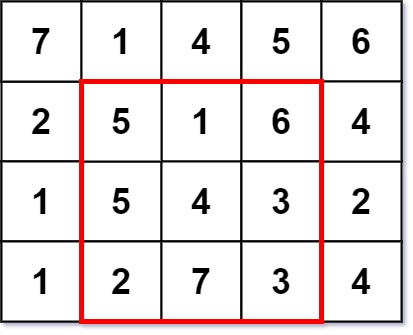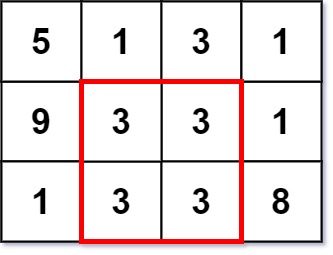- {x}
- Reduction Operations to Make the Array Elements Equal
- Minimum Number of Flips to Make the Binary String Alternating
- Minimum Space Wasted From Packaging
- The Latest Login in 2020
- Cutting Ribbons
- Page Recommendations II
- Check if All the Integers in a Range Are Covered
- Find the Student that Will Replace the Chalk
- Largest Magic Square
- Minimum Cost to Change the Final Value of Expression
- Redistribute Characters to Make All Strings Equal
- Maximum Number of Removable Characters
- Merge Triplets to Form Target Triplet
- The Earliest and Latest Rounds Where Players Compete
- Find a Peak Element II
- Depth of BST Given Insertion Order
- Largest Odd Number in String
- Read More...

Largest Magic Square
A k x k magic square is a k x k grid filled with integers such that every row sum, every column sum, and both diagonal sums are all equal. The integers in the magic square do not have to be distinct. Every 1 x 1 grid is trivially a magic square.
Given an m x n integer grid, return the size (i.e., the side length k) of the largest magic square that can be found within this grid.
Example 1:

Input: grid = [[7,1,4,5,6],[2,5,1,6,4],[1,5,4,3,2],[1,2,7,3,4]] Output: 3 Explanation: The largest magic square has a size of 3. Every row sum, column sum, and diagonal sum of this magic square is equal to 12. - Row sums: 5+1+6 = 5+4+3 = 2+7+3 = 12 - Column sums: 5+5+2 = 1+4+7 = 6+3+3 = 12 - Diagonal sums: 5+4+3 = 6+4+2 = 12
Example 2:

Input: grid = [[5,1,3,1],[9,3,3,1],[1,3,3,8]] Output: 2
Constraints:
m == grid.lengthn == grid[i].length1 <= m, n <= 501 <= grid[i][j] <= 106
Solution Explanation
This problem asks to find the largest magic square within a given grid. A magic square is a square grid where the sum of each row, column, and both diagonals are equal. The solution uses a prefix sum approach to efficiently check for magic squares of various sizes.
Approach:
-
Prefix Sum: The solution first computes the prefix sums for rows and columns.
rowsum[i][j]stores the sum of elements in rowifrom column 1 toj, and similarly forcolsum. This allows for O(1) calculation of the sum of any sub-array. -
Iterative Check: The code iterates through potential magic square sizes, starting from the maximum possible size (
min(m, n)) down to 1. For each sizek, it iterates through all possiblek x ksubgrids. -
check()Function: The core logic resides in thecheck()function. This function verifies if a givenk x ksubgrid is a magic square. It does this by:- Calculating the sum of the first row.
- Checking if all other rows have the same sum.
- Checking if all columns have the same sum.
- Checking if both diagonals have the same sum.
-
Return Value: If a magic square of size
kis found, the function immediately returnsk. If no magic square is found for any size, it returns 1 (as a 1x1 grid is always a magic square).
Time Complexity Analysis:
- Prefix sum calculation takes O(m*n) time.
- The nested loops iterate through all possible subgrid sizes and positions. The number of
k x ksubgrids is roughly O((m-k+1)(n-k+1)). Sincekranges from 1 tomin(m,n), the total number of iterations is approximately O(m*n). - The
check()function takes O(k) time.
Therefore, the overall time complexity is dominated by the nested loops and is O(mnmin(m,n)). This could be approximated as O(m²n) if m and n are of similar magnitude.
Space Complexity Analysis:
- The prefix sum matrices
rowsumandcolsumrequire O(m*n) space. - Other variables use constant space.
Therefore, the space complexity is O(m*n).
Code Explanation (Python):
The Python code follows the approach described above. The rowsum and colsum are initialized, and the check() function verifies the magic square property. The main loop efficiently searches for magic squares of decreasing sizes.
Code Explanation (Other Languages):
The Java, C++, Go, and TypeScript codes implement the same algorithm with minor syntactic differences. The core logic remains consistent across all languages. The prefix sum arrays are created and used to efficiently calculate row and column sums. The check function performs the validation of the magic square property. The main loop iterates through possible square sizes and checks subgrids within the grid for the magic square property.